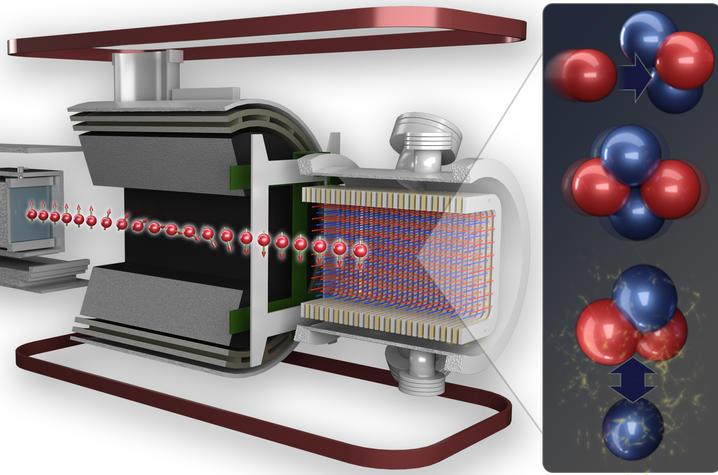By Jenny Wells-Hosley and Sara Shoemaker

The experiment measured the weak force between protons and neutrons by detecting the tiny electrical signal produced when a neutron and a helium-3 nucleus combine and then decay as they move through the helium gas target cell. Andy Sproles/ORNL, U.S. DOE.
LEXINGTON, Ky. (Sept. 28, 2020) — Chris Crawford, a professor in the University of Kentucky College of Arts and Sciences’ Department of Physics and Astronomy, is the co-leader of a team that just precisely measured the weak interaction between protons and neutrons, also known as the weak force — one of four fundamental forces in nature.
The one-of-a-kind experiment was executed at the U.S. Department of Energy’s Oak Ridge National Laboratory and is the culmination of a decade of research, preparation and analysis. The result quantifies the weak force theory as predicted by the Standard Model of Particle Physics.
The team’s observation, detailed in Physical Review Letters, was measured through a precision experiment called n3He, or n-helium-3, that ran at Oak Ridge's Spallation Neutron Source. Their finding yielded the smallest uncertainty of any comparable weak force measurement in the nucleus of an atom to date, which establishes an important benchmark.
Crawford described the experiment as “akin to searching for a 1-inch needle in a 40-foot-high barn full of hay,” and the results have changed the way nuclear physicists understand the role of the weak force in atomic nuclei.
The American Physical Society describes the work as a spectacular achievement in Physics magazine:
"Its impact is best seen in the larger landscape of parity-violating nuclear forces and interactions. ... It is when the results of the n3He and other experiments — the NPDGamma experiment, the polarized proton-proton scattering experiment, and future few-nucleon experiments — are combined with a robust, quantum chromodynamics (QCD)-based, theoretical understanding that we can start to disentangle the interplay of the fundamental forces in the nucleons. ... Eventually, understanding QCD and its interplay with other forces in nuclear systems will enable us to use nuclei to search for hints of new particles and new forces that are beyond the standard model."
Read the full press release from ORNL: www.ornl.gov/news/scientists-achieve-higher-precision-weak-force-measurement-between-protons-neutrons.
The University of Kentucky is increasingly the first choice for students, faculty and staff to pursue their passions and their professional goals. In the last two years, Forbes has named UK among the best employers for diversity, and INSIGHT into Diversity recognized us as a Diversity Champion three years running. UK is ranked among the top 30 campuses in the nation for LGBTQ* inclusion and safety. UK has been judged a “Great College to Work for" three years in a row, and UK is among only 22 universities in the country on Forbes' list of "America's Best Employers." We are ranked among the top 10 percent of public institutions for research expenditures — a tangible symbol of our breadth and depth as a university focused on discovery that changes lives and communities. And our patients know and appreciate the fact that UK HealthCare has been named the state’s top hospital for four straight years. Accolades and honors are great. But they are more important for what they represent: the idea that creating a community of belonging and commitment to excellence is how we honor our mission to be not simply the University of Kentucky, but the University for Kentucky.
